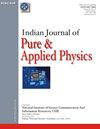Natural Radionuclides in Surface Soil and Quantification of Associated Radiological Hazards in Fatehabad and Hisar districts, Haryana, India
IF 1.1
4区 物理与天体物理
Q4 PHYSICS, MULTIDISCIPLINARY
引用次数: 0
Abstract
Elevated levels of primordial radionuclides (238U/ 232Th- decay series and 40 K) are the foremost source of higher background radiations. Natural radioactive elements may prove precariously radioactive in some situations. So, it is essential to quantify the natural levels of radioactivity in the soil to figure out how much the population is exposed to, what the health risks are, and have a starting point for figuring out how radioactivity in the environment will change due to human activities. In this study natural radioactivity in the soil of different residential areas of Fatehabad and Hisar districts in Haryana, India has been quantified. HPGe gamma spectrometry has been used to quantify the activity of 226Ra, 232Th, and 40K in the soil of the area under investigation. The respective activity concentration of 226Ra, 232Th, and 40K ranged 32 to 53 Bq kg−1, 23 to 41 Bq kg−1, and 402 to 610 Bq kg−1. The activity equivalent to radium only (Raeq), the air absorbed dose rate (AAD), the effective dose equivalent rate(AEDEC), the gonadal dose equivalent rate (AGDE), the external risk index, the internal risk index, the index for gamma level, cancer risk for an average lifetime, etc. were calculated and compared with the international standards. Each sample of soil had lesser radium equivalent activities than the permissible limit, i.e., 370 Bq kg-1primarily set by the Organisation for Economic Co-operation and Development (OECD), and the effective dose equivalent was below the safe limit of 1.0 mSv y-1. Organ-specific dose values are pretty considerable but not in the danger zone. The Clark value refuses the probability of finding any uranium ore. This study indicates that the area being studied is a place with low background radiation exposure from radionuclides.印度哈里亚纳邦Fatehabad和Hisar地区表层土壤中的天然放射性核素和相关辐射危害的量化
高水平的原始放射性核素(238U/ 232Th衰变系列和40k)是高背景辐射的主要来源。天然放射性元素在某些情况下可能具有危险的放射性。因此,有必要量化土壤中的自然放射性水平,以确定人口受到多少辐射,健康风险是什么,并有一个起点,以确定环境中的放射性如何因人类活动而变化。本研究对印度哈里亚纳邦Fatehabad和Hisar地区不同居民区土壤中的天然放射性进行了量化。采用HPGe能谱法定量测定了该地区土壤中226Ra、232Th和40K的活性。226Ra、232Th和40K的活性浓度分别为32 ~ 53 Bq kg - 1、23 ~ 41 Bq kg - 1和402 ~ 610 Bq kg - 1。计算了辐射辐射的放射性当量(Raeq)、空气吸收剂量率(AAD)、有效剂量当量率(AEDEC)、性腺剂量当量率(AGDE)、外部风险指数、内部风险指数、γ水平指数、平均一生癌症风险等指标,并与国际标准进行了比较。每个土壤样品的镭当量活度低于经济合作与发展组织(经合组织)主要规定的容许限度,即370 Bq kg-1,有效剂量当量低于1.0 mSv -1的安全限度。器官特异性剂量值相当可观,但不在危险范围内。克拉克值拒绝了发现任何铀矿石的可能性。这项研究表明,所研究的地区是一个放射性核素本底辐射暴露低的地方。
本文章由计算机程序翻译,如有差异,请以英文原文为准。
求助全文
约1分钟内获得全文
求助全文
来源期刊
CiteScore
1.30
自引率
14.30%
发文量
42
审稿时长
7 months
期刊介绍:
Started in 1963, this journal publishes Original Research Contribution as full papers, notes and reviews on classical and quantum physics, relativity and gravitation; statistical physics and thermodynamics; specific instrumentation and techniques of general use in physics, elementary particles and fields, nuclear physics, atomic and molecular physics, fundamental area of phenomenology, optics, acoustics and fluid dynamics, plasmas and electric discharges, condensed matter-structural, mechanical and thermal properties, electronic, structure, electrical, magnetic and optical properties, cross-disciplinary physics and related areas of science and technology, geophysics, astrophysics and astronomy. It also includes latest findings in the subject under News Scan.

 求助内容:
求助内容: 应助结果提醒方式:
应助结果提醒方式:


